Click on images to enlarge
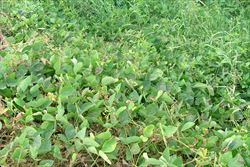
infestation (Photo: Sheldon Navie)
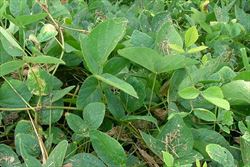
habit (Photo: Sheldon Navie)
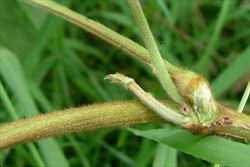
close-up of hairy stem, leaf stalk and new shoots (Photo: Sheldon Navie)
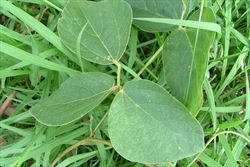
compound leaf with three large leaflets (Photo: Sheldon Navie)

close-up of leaflet (Photo: Sheldon Navie)

leaflet underside (Photo: Sheldon Navie)
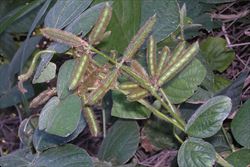
very hairy immature fruit (Photo: Chris Gardiner)
Scientific Name
Calopogonium mucunoides Desv.
Synonyms
Calopogonium brachycarpum (Benth.) Benth. ex Hemsl.Calopogonium orthocarpum Urb.Stenolobium brachycarpum Benth.
Family
Fabaceae (Queensland, the ACT, Victoria, Tasmania and the Northern Territory)Fabaceae: subfamily - Faboideae (New South Wales)Leguminosae (South Australia)Papilionaceae (Western Australia)
Common Names
calapo, calopo, wild ground nut
Origin
Native to Mexico, Central America (i.e. Belize, Costa Rica, El Salvador, Guatemala, Honduras, Nicaragua and Panama), the Caribbean and tropical South America (i.e. French Guiana, Guyana, Surinam, Venezuela, Colombia, Ecuador and Peru).
Naturalised Distribution
Naturalised in northern Queensland and the northern parts of the Northern Territory. It is most widespread in the Darwin and Gulf regions of the Northern Territory and on the Cape York Peninsula in far northern Queensland.
Also naturalised on Christmas Island and in other tropical regions of the world (e.g. Papua New Guinea, Indonesia, the Philippines and Malaysia).
Notes
Calopo (Calopogonium mucunoides) is a vine that was introduced into Australia as a pasture legume. It has become naturalised in disturbes sites, waste areas and crops, along roadsides and waterways, and on the edges of rainforests in the wetter tropical regions of northern Australia. It is most common in the Darwin region and in surrounding bushland, and has also become a weed in Kakadu National Park. In these areas, populations are extending rapidly and it has been observed to form dense mats that smother native vegetation.

